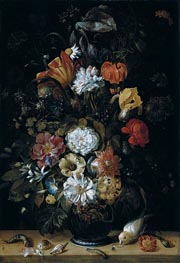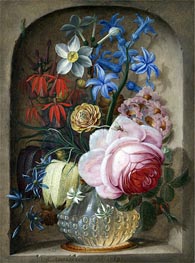Johann Adalbert Angermayer Painting Reproductions 1 of 1
1674-1740
Bohemian Baroque Painter
Johann Adalbert Angermayer, born in Bílina in 1674, was an artist deeply entrenched in the traditions of still life painting, but his meticulous approach and distinctive compositions set him apart from his peers. A product of the late Baroque period, Angermayer’s work is firmly rooted in the cabinet still life tradition - small, detailed compositions that were often intimate in scale but grand in execution. His paintings invite viewers into a world of minute observations, where every flower petal, jewel, or hunting trophy is rendered with an almost obsessive clarity. In a time when opulence and grandeur dominated much of European art, Angermayer’s quietly detailed canvases offered a different kind of luxury - one of precision and contemplation.
He moved to Prague in 1699, where he studied under the accomplished still life painter Johann Rudolf Byss. Byss himself had spent time in the Netherlands, absorbing the influence of the Leiden Fijnschilders - a group known for their jewel-like precision in painting. This influence filtered through to Angermayer, whose work was marked by the same dedication to lifelike detail and delicate brushwork. He officially joined the Old Town Painter Guild in 1707, cementing his place in Prague’s artistic scene. Though small in size - rarely exceeding 35 cm - his still life compositions were rich with visual detail, designed to be viewed up close, where every brushstroke could be appreciated.
Angermayer’s subjects were varied but often followed the conventions of the time - flowers, luxurious fabrics, hunting trophies, and everyday objects that took on new significance under his gaze. However, his ability to bring life to these traditional subjects was remarkable. Works like "Still Life with a Watch" or "Still Life with a Jewelry Box" from 1708 show his tendency to experiment with composition, bringing a sense of narrative or quiet reflection into his paintings. There’s something almost meditative in the way he captures the gleam of metal, the softness of velvet, or the fragile delicacy of a flower in bloom.
Although much of his life was spent in Prague, including a significant period working for the Monastery of Osek between 1719 and 1722, his influence extended beyond his immediate surroundings. His pupils, including John Caspar Hirschely and Carl Kastner, carried forward his meticulous style, ensuring that his approach to still life remained relevant even as artistic tastes shifted toward Rococo’s lightness and fluidity.
Johann Adalbert Angermayer’s legacy lies not in grand statements or monumental works but in his unwavering commitment to detail and the quiet power of observation. He passed away in 1742, leaving behind a body of work that continues to captivate those willing to look closely. His paintings remind us of the beauty in the overlooked, the small moments and objects that, through his eyes, became timeless.
He moved to Prague in 1699, where he studied under the accomplished still life painter Johann Rudolf Byss. Byss himself had spent time in the Netherlands, absorbing the influence of the Leiden Fijnschilders - a group known for their jewel-like precision in painting. This influence filtered through to Angermayer, whose work was marked by the same dedication to lifelike detail and delicate brushwork. He officially joined the Old Town Painter Guild in 1707, cementing his place in Prague’s artistic scene. Though small in size - rarely exceeding 35 cm - his still life compositions were rich with visual detail, designed to be viewed up close, where every brushstroke could be appreciated.
Angermayer’s subjects were varied but often followed the conventions of the time - flowers, luxurious fabrics, hunting trophies, and everyday objects that took on new significance under his gaze. However, his ability to bring life to these traditional subjects was remarkable. Works like "Still Life with a Watch" or "Still Life with a Jewelry Box" from 1708 show his tendency to experiment with composition, bringing a sense of narrative or quiet reflection into his paintings. There’s something almost meditative in the way he captures the gleam of metal, the softness of velvet, or the fragile delicacy of a flower in bloom.
Although much of his life was spent in Prague, including a significant period working for the Monastery of Osek between 1719 and 1722, his influence extended beyond his immediate surroundings. His pupils, including John Caspar Hirschely and Carl Kastner, carried forward his meticulous style, ensuring that his approach to still life remained relevant even as artistic tastes shifted toward Rococo’s lightness and fluidity.
Johann Adalbert Angermayer’s legacy lies not in grand statements or monumental works but in his unwavering commitment to detail and the quiet power of observation. He passed away in 1742, leaving behind a body of work that continues to captivate those willing to look closely. His paintings remind us of the beauty in the overlooked, the small moments and objects that, through his eyes, became timeless.
2 Johann Adalbert Angermeyer Paintings

Bouquet of Flowers with Animals 1704
Oil Painting
$3476
$3476
Canvas Print
$61.75
$61.75
SKU: AAJ-4262
Johann Adalbert Angermayer
Original Size: unknown
Liechtenstein Museum, Vienna, Austria
Johann Adalbert Angermayer
Original Size: unknown
Liechtenstein Museum, Vienna, Austria

Flowers in a Vase in a Stone Niche 1719
Oil Painting
$2222
$2222
Canvas Print
$61.75
$61.75
SKU: AAJ-4263
Johann Adalbert Angermayer
Original Size: unknown
Private Collection
Johann Adalbert Angermayer
Original Size: unknown
Private Collection